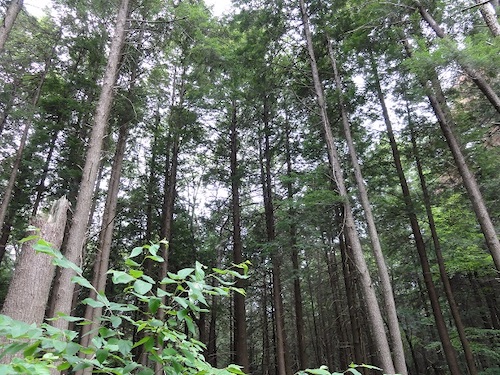The Chronicles Of Grant County
Hemlock Street
Deming
 Hemlock trees at the Flight 93 Memorial Witness Grove in western Pennsylvania. (The photograph was provided courtesy of the United States Forest Service, July 13, 2012.)
Hemlock trees at the Flight 93 Memorial Witness Grove in western Pennsylvania. (The photograph was provided courtesy of the United States Forest Service, July 13, 2012.)
Hemlock Street in Deming was named after the Hemlock tree.
This tree grows in New Mexico as well as throughout the United States.
The Hemlock tree is different from the Hemlock plant. (More on the plant later in this news column.)
The United States Department of Agriculture (USDA) indicated in a brochure entitled "Trees of the Carson National Forest" that the Hemlock tree was similar to the Douglas Fir tree.
This brochure detailed that the Douglas Fir tree is "the largest native evergreen tree in New Mexico and Arizona. It is the most important timber species in the U S and is one of the commercial species of New Mexico. The tree is rather a botanical puzzle, for it bears a strong resemblance to Spruce [trees] and Fir [trees] as well to Hemlock [trees] and Yew [trees]."
Depending on the section of the country, the Hemlock tree is affected negatively by a specific insect.
"Major Forest Insect and Disease Conditions in the United States: 2022," a brochure issued in November of 2023 by the USDA, indicated that a threat to Hemlock trees in the Eastern U S does not affect Hemlock trees in Western states like New Mexico.
"The Hemlock woolly adelgid (HWA) is a cryptic species with at least ten distinct genetic lineages, two of which are considered established in the continental United States," according to this USDA brochure. "In western North America, the linage is considered native and does not cause significant damage to western Hemlocks. In the Eastern United States, a different linage established from Japan is considered invasive and causes high levels of mortality to eastern Hemlocks. Introduced in 1951, the HWA can now be found throughout the range of Hemlock [trees] in North America."
As noted above, the Hemlock tree and the Hemlock plant are not the same.
"Poison-Hemlock grows throughout the United States," the USDA detailed in a statement updated as of June 26, 2018. "It is very toxic and sheep, cattle, swine, horses, and other domestic animals are poisoned by eating small amounts of green or dried plant. It is also extremely poisonous to humans. Poison-Hemlock is sometimes confused with western water Hemlock, a more deadly species, because the names are similar."
The USDA indicated that other names for Poison-Hemlock include "Deadly Hemlock," "Poison Parsley," "Spotted Hemlock," "European Hemlock," "California Fern," and "Nebraska Fern."
"Poison-Hemlock has white flowers that grow in small erect clusters," the USDA updated statement continued. "Each flower develops into a green, deeply ridged fruit that contains several seed. After maturity, the fruit turns grayish brown. Poison-Hemlock starts growing in the early spring. It usually grows for two years, but in favorable locations it may be a perennial. Roots of poison-Hemlock may easily be mistaken for wild parsnips. It may be 2 to 3 meters tall. The hollow stem usually is marked with small purple spots. Leaves are delicate, like parsley, and it has a white taproot. Poison-Hemlock is a biennial in the parsnip or wild carrot family."
According to the USDA, "Poison-Hemlock grows along fence lines, in irrigation ditches, and in other moist waste places."
This plant is especially dangerous to livestock.
"Poison-Hemlock ingestion frequently is fatal," noted the USDA statement updated in 2018. "Sheep may be poisoned by eating as little as 100 to 500 gm of green leaves. Cattle that eat 300 to 500 gm may be poisoned. Signs usually appear within an hour after an animal eats the plant. Animals die from respiratory paralysis in two to three hours. Convulsions, which are common in western water Hemlock poisoning, seldom occur with poison-Hemlock."
Beyond the immediate impact on adult livestock, Poison-Hemlock can cause severe problems for pregnant livestock.
"Skeletal deformities or cleft palate may be induced in offspring of cows, sheep, goats, and pigs that eat poison-Hemlock during gestation," the updated statement from the USDA continued. "Susceptible stages of gestation when animals should not be exposed to this plant include 40 to 70 days in cows and 30 to 60 days in sheep, goats, and pigs. Palate and skeletal deformities in calves are indistinguishable from the lupine-induced crooked calf disease."
Do you have questions about communities in Grant County?
A street name? A building?
Your questions may be used in a future news column.
Contact Richard McDonough at
If your email does not go through, please contact
© 2024 Richard McDonough












